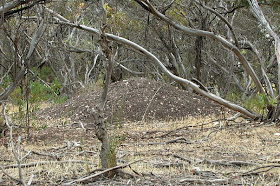Some birds have certain behaviors and adaptations that make them not your
average birds.
The first example is the Black Heron, also known as the Black Egret, native to Africa.
Black herons are found south of the Sahara Desert, including
Madagascar.
Are those umbrellas in the water?
Nope, they’re birds! This
behavior is called canopy feeding.
The black heron spreads its wings and ducks its head under its wings to
shade the water from the bright sun.
This helps the heron to see its prey fish – under the water. Even better, it may lure fish looking
for a cool shady spot. The fish
unknowingly swims right to the heron’s
beak! Check out this video clip. They mainly eat fish, but they will
also snack on crustaceans (crabs and crayfish), aquatic insects and amphibians.
The Burchell’s sandgrouse is literally a desert sponge.
Burchell’s sandgrouse is one of 16 species of sandgrouse in the
family Pteroclididae.
They are found in very dry areas of southern Africa and they eat dry food –
hard little seeds. These birds
still need water, so they sometimes spend hours every day searching for a
puddle, pond or pool to drink from.
But what makes these birds amazing is they have special water-holding
feathers on their bellies, and when they finally find water, a male sandgrouse
will soak up droplets of it. He
will then carry the precious cargo back to his nest of chicks for them to drink
from. What an amazing adaptation! Although the chicks are precocial –
they leave the nest almost as soon as they hatch – they still cannot fly to
watering holes yet. Yet, they are
mobile on foot and capable of feeding themselves. They still remain close to the nest and
learn skills from their parents for several months. Also, at first the chicks are too small and young to
thermoregulate (maintain correct body temperature), so the parents provide them
with shade during hot parts of the day and warmth through brooding at night.
Australian Malleefowl males are super dads!
Australian malleefowl are stocky ground-dwelling birds about
the size of a domestic chicken. They eat herbs, seeds,
invertebrates, fungi and fruit as is available.
Australian malleefowl occupy semi-arid scrub on the edges of the moderately
fertile regions of southern Africa.
In winter, the male will begin to construct a huge nest mound. He will first dig a depression in the
ground, about 9 feet wide and 3 feet deep, by scraping backwards with his
powerful feet. In late
winter/early spring he will begin to collect sticks, leaves and bark to fill
the depression (up to 2 feet above ground level) and he will continue to scrape
materials for up to 150 feet around the hole. He waits for rain. Then he will turn and mix the material to boost decay
producing warmth, and dig an egg chamber.
Australian malleefowl nest mound
The female will then lay one egg per week for an average of 15 weeks. The egg chamber is covered with a layer
of sand for insulation. The eggs
cannot get too hot or cold, so dad sticks his temperature sensitive beak in the mound each day to check the
temperature. In order to make the
nest cooler or warmer, he scratches sand away creating air vents, or piles it
back on. I also found it amazing
that it can take up to 15 hours for a newly hatched chick to reach the surface
of the mound! Once it emerges, it
quickly staggers or rolls down the mound and scurries away, never again to see
its siblings, mom, or dad, who worked so hard!
The Sociable Weaver of southern Africa builds huge bird condos!
Sociable weavers are mostly insectivorous, insects making up
80% of their diet and seeds and plants 20%.
As their name suggests these birds construct amazing community nests by
weaving together grasses and other plant material. The nests are large enough to
house over one hundred pairs of birds!
They team up to build a nest with tunnels and chambers, which several
generations will inhabit at one time.
This nest continues to grow every year. The nest appears like a haystack in a tree or on a telephone
poll. When looked at from below,
many holes for entering can be seen.
Check out this video. The entire structure can weigh more
than a ton and sometimes other species of birds will move in, too!
The nests of sociable weavers are among the largest bird-made
structures.
These four birds look like they are just your average birds, but they all
have a weird behavior or adaptation that makes them stand out as unique!
You can help in the World Bird Sanctuary’s mission of maintaining earth’s
biological diversity so future generations can enjoy the same amazing
animals. You can visit us and spread
what you learn, become a member or friend or adopt-a-bird and feed that bird
for a year!
Submitted by Sara Oliver,
World Bird Sanctuary Naturalist







No comments:
Post a Comment